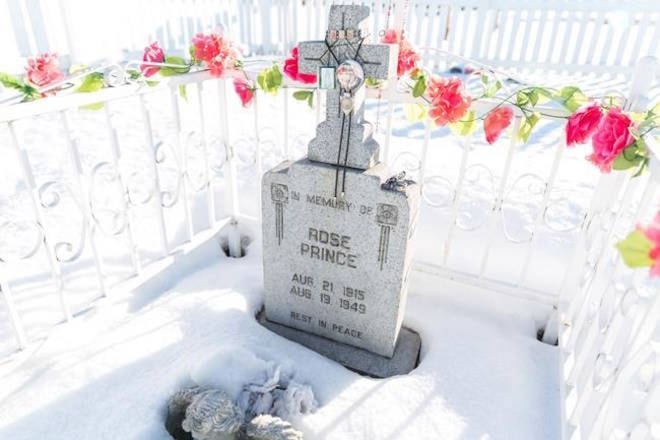Each July, visitors travel to Rose Prince’s grave at the former Lejac Residential School, Fraser Lake which is all that remains of the school, but it brings Indigenous and non-Indigenous visitors on pilgrimages every year seeking strength for spiritual and physical healing.
Rose Prince arrived at the former Catholic-run institution when she was six years old and never left.
She was known for her devout faith, compassion, humility and self-sacrifice. But it’s the almost unreal circumstances surrounding her death and claims of healing that prompts the pilgrimage.
Prince was 34 when she died of tuberculosis in 1949. It has been reported that Prince’s body did not cool after she died at the St. John Hospital in Vanderhoof.
When her grave site was disturbed by construction two years later, her opened casket revealed her body hadn’t decayed.
“The workers were amazed to find her body and clothing perfectly preserved,” says a brochure produced by the Prince George diocese.
“They found her body in perfect condition. She seemed to be transparent and looked as if she were sleeping. There was ‘just a tiny bit of a smile on her face.’ A bouquet of withered flowers was on her chest.”
Grave diggers, nuns and priests from the residential school reported a floral scent in the air. Only the bouquet of flowers she was buried with had wilted.
Among Catholics, unexplained “incorruption” of the body is believed to be a sign of a life of holiness and reflects the victory of Christ over death and Rose Prince’s acclaim has even gained the attention of the Vatican as a possible candidate for sainthood. Many Indigenous people across B.C. already consider Prince a saint, he said, but the church may still take decades to decide.
“She’s a special person in our peoples’ history and we revere her in many respects,” says Grand Chief Ed John, the leader of the First Nations Summit, one of B.C.’s largest Indigenous organizations. “We’ve heard stories of people who have had miraculous cures. I understand the church has taken steps to document that.”
Jack Lacerte was 10 years old when he saw Prince’s body after the coffin opened in 1951 as he helped his father, who was a caretaker at the school.
Lacerte died three years ago and was the last surviving person who saw the body, but his wife Shirley said her husband — one of Canada’s first Indigenous RCMP officers — never changed his story.
The pilgrimages to the Lejac school site, which started in 1990, bring people from across Western Canada and the North, said Rev. Vince James of St. Andrew’s Parish in Fraser Lake.
Fraser Lake miner Nick Loza told the Vancouver Sun in the 1990s he became pain free after soil from Prince’s grave was mixed with holy water and rubbed on his damaged spine.
James said he sees the pilgrimages as “people gathering to share their faith with each other.”
“I believe that Rose is a great soul and a holy woman. Some people claim that, through her intercession, they’re healed physically or spiritually.”
He said the church moves slowly on matters of sainthood, but “Rome knows about Rose. We’ve sent information over that we had.”
James said a Vatican official has visited the parish about Prince.
The Vatican’s five steps to sainthood involve waiting five years after the person’s death, becoming a servant of God, showing proof of a life of heroic virtue, verifying miracles and canonization.
James said the pilgrimages are emotional gatherings because Prince brings together many wounded by their residential school experiences at the former school, which was torn down in 1976.
Among the school’s darkest chapters was the death of four boys in 1937. Ranging in age from seven to nine, the boys froze to death in January 1937 on Fraser Lake after running away from the school in -29 ‘C temperatures.
Prince was at the school when the boys died.
“They were found huddled together on the ice the next morning,” said John. “It’s just tragic. It’s heartbreaking for us to see it now.”
He said the boys were trying to get home, much the same as Chanie Wenjack, the Indigenous youth who died trying to return to his family from a residential school in Ontario. Wenjack’s journey became the subject of an illustrated book and recording by the Tragically Hip’s Gord Downie, who died last year.
Wilma Pattison said she considers her aunt a saint who lived a devout life where worldly things did not matter.
Prince died when Pattison was three years old, but she’ll never forget walking into St. Andrew’s Parish in Fraser Lake for her first time almost 50 years ago.
Minutes after entering the church, Pattison said Sister Mary Ann gave her a greeting card made by Prince. The card was dated July 1948, the year before she died, and was addressed to the nun.
Sister Mary Ann said she vowed to give the card to the first person from Prince’s family to come to the church.
Pattison says the card is signed, “With Love from Rose Prince.”
“May all the days of all the years that God has still in store be filled with every joy and grace to bless you more and more,” said one of the handwritten verses.
- with files from The Canadian Press.
